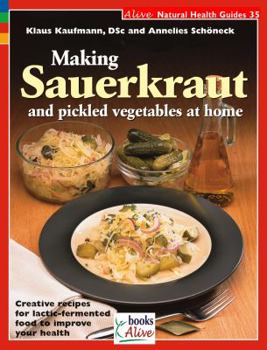Making Sauerkraut and Pickled Vegetables at Home: Creative Recipes for Lactic-Fermented Food to Improve Your Health
Select Format
Select Condition 
Book Overview
With this book, discover the simple remedies and healing agents found in lactic acid-fermented foods. Step-by-step recipes will guide you, the modern reader, through centuries-old methods. Book... This description may be from another edition of this product.
Format:Paperback
Language:English
ISBN:155312037X
ISBN13:9781553120377
Release Date:January 2000
Publisher:Alive Books
Length:60 Pages
Weight:0.40 lbs.
Dimensions:0.2" x 6.6" x 8.5"
Customer Reviews
4 ratings
Complete Guide
Published by Thriftbooks.com User , 17 years ago
This book is a complete guide to making sauerkraut; in fact, it was like having my grandmother beside me. The methods she used were given step by step in this book and the saurkraut we made is perfect. We are going to do a crock of pickled vegetables this summer using the book as a guide.
Practical sauerkraut book
Published by Thriftbooks.com User , 17 years ago
Even though this is a thin book, this is packed with information - basically everything you need to get you started. The author(s) talk about why people make sauerkraut/pickles, a little bit about their use in various ancient and more modern cultures and how pickles saved the sailors from scurvy starting with 18th century, when ships started carrying them. Sauerkraut/pickles are fermented foods, and the fermentation happens because of lacto-bacteria (named like that because they were first discovered in milk/dairy products). Actually, there are two types of them: for milk products and for vegetables. Organic products have more bacteria and ferment easier. Raw (i.e. unpasterized) milk sours by itself; pasteurized milk spoils... The white film you can find on organic veggies (e.g. plums, cabbage) is lacto-bacteria. Those bacteria - and fermented products in general - are beneficial for digestion. The best container for fermentation is Harsch - search the web to see it. I learned from this book that the white yeast that appears over open fermentation pots is actually harmless, just it has a bad taste. It is easier to get better results with more veggies or with more types of plants versus one type only. Salt is needed for fermentation, authors say, to allow veggies to withstand a couple of days without decay until fermentation begins. If you have organic veggies, or good container (such as Harsch), there is less need for it. Whey could also be substituted, but not fully (i.e. you still need some salt). What else is in the book? The spices, of course. And some therapeutical applications of pickles. And, last but not least, some recipes that seem interesting to me.
Best of show
Published by Thriftbooks.com User , 17 years ago
This book does exactly what the cover promises. The layout and format is clean and the flow of information is logical as well as being easy to digest. Not only does this little book go into details of pickling cabbages and other veggies, it does you one better. There is extensive treatment on the healthful advantages of eating cultered vegetables. For example, did you know that eating a pound of sauerkraut a day for three months, will shrink and remove colon polyps? Then just when you think you couln't cram any more information into a little book, you are given some great ideas on what to do with your lacto-fermented foods, in a recipe section. All in all, a much better experience than "Wild Fermentation" and absolutely no political axe to grind. If you are looking for a no-nonesense introduction to making your own lactic fermented food, then you are in the right place.
Good eating and a health store all in one book
Published by Thriftbooks.com User , 18 years ago
This is a great book. If you want to learn why fermented foods are so much better for you than pastuerized and heated products along with learning how to prepare them yourself, then this book is for you. It even describes a crock that eliminates all chances of spoilage or maintenance. The contents are sealed from the air the whole time the contents are fermenting. You can even use less salt. The finished product comes out crisp, fresh, and with incredible flavor.





